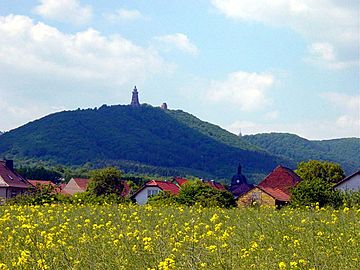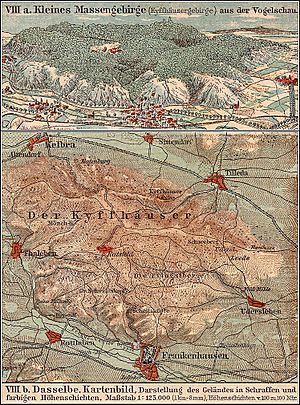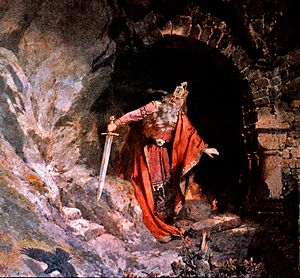Kyffhäuser facts for kids
Quick facts for kids Kyffhäuser |
|
|---|---|

View from Tilleda of the hills and the Kyffhäuser Monument
|
|
| Highest point | |
| Peak | Kulpenberg |
| Elevation | 1,553 ft (473 m) |
| Geography | |
| Country | Germany |
| Geology | |
| Orogeny | Variscan |
| Type of rock | Sandstone, Conglomerate, Carboniferous sedimentary and metamorphic rocks |
The Kyffhäuser (pronounced: Kiff-hoy-zer) is a range of hills in Central Germany. These hills are shared by two German states: Thuringia and Saxony-Anhalt. They are located southeast of the Harz mountains. The highest point in the Kyffhäuser range is the Kulpenberg, which is about 473 meters (1,553 feet) tall.
This area is famous for the old Kyffhausen Castle from the Middle Ages and the Kyffhäuser Monument, built in the 1800s. The Kyffhäuser also plays a big part in German stories. Many people believe it's the legendary resting place of Emperor Frederick Barbarossa.
Contents
What's in a Name?
The exact meaning of the name Kyffhäuser isn't fully known. It might come from an old German word, cuf, which means "head" or "peak," and huse, meaning "house." So, it could mean "peak house." Other ideas suggest it comes from a word meaning "quarrel," perhaps because of the old castles there.
Where is the Kyffhäuser?
The Kyffhäuser is a small Mittelgebirge (a German term for a low mountain range or hills). It's found in the Kyffhäuserkreis district of Thuringia and the Mansfeld-Südharz district of Saxony-Anhalt. It's not far from the larger Harz mountains.
The range stretches about 19 kilometers (12 miles) from west to east and is about 7 kilometers (4 miles) wide. The highest point, Kulpenberg, has a TV tower called the Kulpenburg TV tower. This tower is near the village of Steinthaleben in Thuringia. To the south, the Kyffhäuser hills meet the Hainleite hills and a rich farming area called the Goldene Aue. A large part of the Kyffhäuser is protected as a nature park.
Some parts of the hills, especially on the western and southern sides, have karst features. This means the limestone rock has been shaped by water, creating caves and sinkholes. These areas often have no trees and are covered in special grassy areas called calcareous grassland. The area also has many old sandstone quarries. Today, this region is a geopark. It includes the Kyffhäuser Monument, the Barbarossa Cave near Rottleben, the Kaiserpfalz (an old imperial palace) at Tilleda, and the Bilzingsleben Paleolithic site, where very old human tools were found.
Near Bad Frankenhausen, a hill called Schlachtberg was the site of an important battle. This was the Battle of Frankenhausen in 1525, during the German Peasants' War. A huge painting by Werner Tübke remembers this event.
A Look Back in Time
The village of Tilleda, at the northern edge of the Kyffhäuser, was first mentioned in the early 800s. An imperial palace, known as a Kaiserpfalz, was located there. Important emperors like Otto II, Otto III, Conrad II, and Henry III often stayed there and issued official papers.
Later, in the 1000s, a castle was built on the hill above Tilleda. Emperor Henry IV might have built it during a conflict called the Saxon Rebellion. His son, Henry V, continued these fights. The castle was later destroyed by Duke Lothair of Supplinburg in 1119. However, Lothair himself began rebuilding it later. The Imperial Castle of Kyffhausen became one of the largest castle complexes in Germany. It was finished under the famous Hohenstaufen emperor Frederick Barbarossa.
Tilleda was last mentioned as an imperial castle in 1194. This was when Frederick's son, Henry VI, made peace with the rebellious Duke Henry the Lion of the House of Welf here.
In 1698, Count Albert Anton of Schwarzburg-Rudolstadt built a fancy hunting lodge in the middle of the Kyffhäuser range. This lodge was later used by Prince Günther Victor of Schwarzburg after he gave up his rule in 1918. In 1925, it became a holiday home for a veterans' group called the Kyffhäuserbund. After World War II, it was used as a camp for young people and a training camp. Today, the buildings are empty and falling apart.
The Kyffhäuser Legend
There's a famous legend about Emperor Frederick Barbarossa and the Kyffhäuser hills. Even though he actually drowned in a river in Asia Minor during the Third Crusade in 1190, the legend says he isn't really dead. Instead, he sleeps in a secret chamber deep inside the Kyffhäuser hills. He sits at a stone table, and his beard has grown so long over the centuries that it has grown right through the table!
Like the similar legend of King Arthur, Barbarossa is said to be waiting for Germany's greatest time of need. When that time comes, he will wake up and come out from under the hill to help. People say that if you see ravens circling the top of the Kyffhäuser, it's a sign that Barbarossa is still there. Other similar legends talk about Emperor Frederick II or Charlemagne sleeping in other mountains.
The story of Barbarossa was first written down in the late 1600s. It became very popular thanks to the Brothers Grimm and a poem written in 1817 by Friedrich Rückert. Many writers during the Romantic period loved this story. It showed their hope for the old German Empire to rise again as a united country. When the Kyffhäuser Monument was built between 1890 and 1896, it included a statue of Frederick Barbarossa and another of Emperor William I. Many people felt that with Germany's unification in 1871, Emperor William I had "woken up" Barbarossa's dream.
Kyffhäuser Today
Today, the Kyffhäuser hills are a popular place for tourists. You can visit the restored medieval Reichsburg Kyffhausen complex. It has a small museum and a very deep castle well, said to be one of the deepest in the world, at 176 meters (577 feet) deep. The Pfalz (palace) of Tilleda, located downhill, is now an archaeological open-air museum. It's also a stop on the beautiful Romanesque Road.
The area also hosts an annual touring car hillclimbing race and a cross-country running competition called the Kyffhäuser-Berglauf. The Kyffhäuser is a great place for hikers. The Kaiser Way hiking trail crosses the Kyffhäuser and leads north to the Harz mountains.
See also
- List of mountains and hills of Thuringia
- Sebastianism



